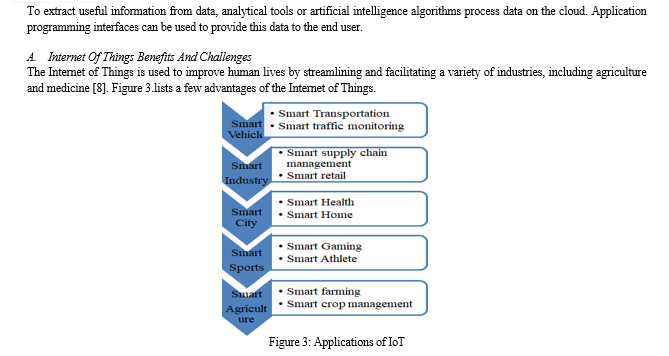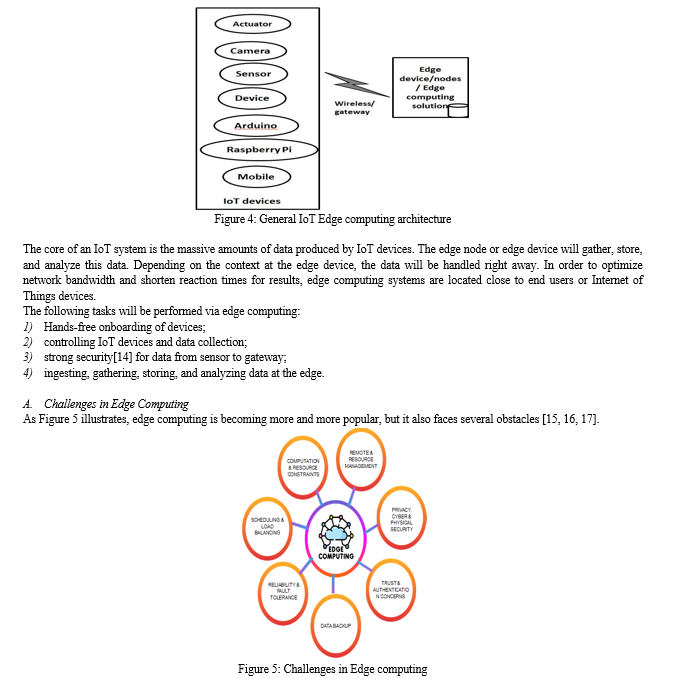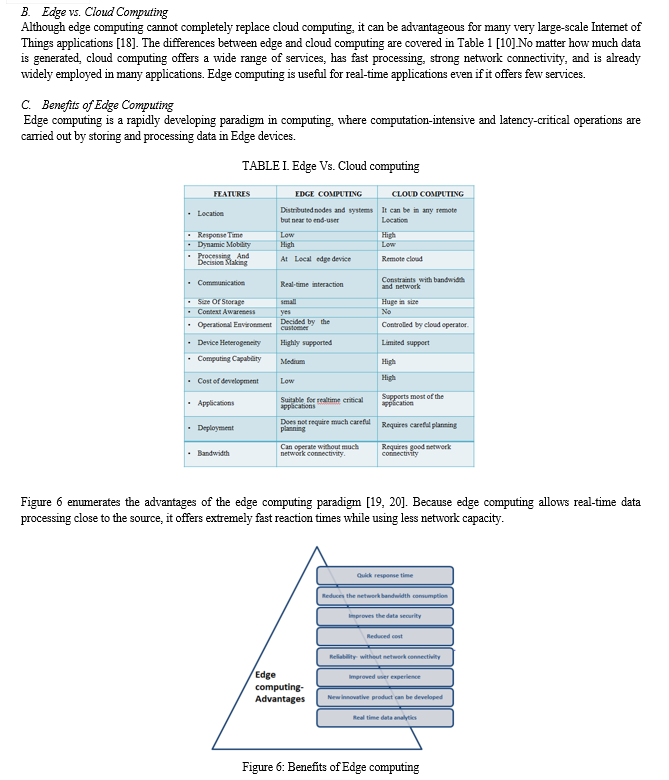Ijraset Journal For Research in Applied Science and Engineering Technology
- Home / Ijraset
- On This Page
- Abstract
- Introduction
- Conclusion
- References
- Copyright
Salient Applications and Obstacles in IOT Edge Computing
Authors: R. Krishna Bharathi, R. Velvizhi Ramya
DOI Link: https://doi.org/10.22214/ijraset.2024.62819
Certificate: View Certificate
Abstract
The Internet of Things (IoT) is a new technology that has emerged in recent years as a result of the exponential rise of linked gadgets. The IoT benefits from cloud computing. Applications to store the data and carry the calculations, that the enormous volume of data produced by these IoT devices may be managed and controlled. However, fulfilling the demands of numerous Internet of Things, real-time applications remains the main problem in cloud computing. On the other hand, Edge or Fog computing is a computing architecture that facilitates data management, processing, storing, and communication while providing a prompt response. By putting these functions closer to the end consumers, this is made possible. For many applications, edge and cloud computing are complementary technologies that work independently of one another. The overview of IoT and communication technologies and IoT protocols, as well as data transit in IoT. We look into cloud services for processing, storing, and analysing the data produced by Internet of Things devices.
Introduction
I. INTRODUCTION
The Internet of Things, or "IoT," is a new field that is being used in many different fields in the digital age. It uses sophisticated communication technologies, protocols, and quick, intelligent data analysis software to enable computing services by utilizing edge and cloud architecture based on user requirements and service quality for various application types.
By enabling Radio-frequency identification (RFID), actuators, and sensors for intelligent decision making based on the user context to improve lives, the Internet of Things (IoT) makes things or devices communicate with each other in turn to enable machine to machine communication.
IoT has been applied over time in many different fields, including the medical, industrial, and transportation sectors [1].
Architectural standardization makes it possible to offer people high-quality services, enhance their quality of life, and grow the global economy.
Since the number of connected devices is growing at an exponential rate, enormous volumes of data are generated. This has led to the development of data analytics on the cloud, which in turn has made cloud computing a developing technology with applications across numerous industries. IoT applications requiring high availability, processing power, and large amounts of storage are deployed with cloud computing [2].
The enhanced potential of IoT allows for data gathering, storing, and analysis at the user level, making it appropriate for time-sensitive real-time applications. Since sustaining Quality of Service (QoS) even with a larger number of devices is crucial, real-time applications must enable real-time interactions with very little delay [3] and very quick reaction times. Often used as a solution, the edge computing paradigm in many applications.
By removing the need to transfer data to the cloud or from the cloud to nearby end devices, the edge computing paradigm enhances Internet of Things applications [4]. The proliferation of wireless sensor nodes, communication technologies, and manufacturing advancements in conjunction with the development of smartphones has resulted in a significant surge in edge computing.
This study aims to offer an understanding of the Internet of Things, specifically combining edge and cloud computing. Benefits, difficulties, and the distinctions between edge and cloud computing were covered. The remainder of this essay is structured as follows: IoT specifics are covered in Section II, cloud computing is briefly discussed in Section III, and edge computing is covered in Section IV.
II. NOVEL VIEWPOINTS ON IOT
The concept known as the Internet of Things (IoT) enables several computing devices to connect and exchange data via wired or wireless networks. By integrating sensors, objects, or gadgets become intelligent.
This can be done with or without human-to-human or human-to-computer contact. Sensors are used to collect data and analyze it. Internet of Things (IoT): the capacity to link numerous physical objects, including wearables and street lights, and use those connections to share the data, communicate, and take action.
This increased the potential of IoT use in a number of IoT applications, including smart wearables for medical purposes, smart appliances, smart meters, smart cities, smart traffic monitoring, and weather condition monitoring devices.
Components of IoT
The four parts of an Internet of Things system is illustrated in Figure 1. These are actual hardware components that include sensors, network connectivity, data processing, and an application user interface built in.


- The Internet of Things is a rapidly developing technology that has many applications across numerous industries. The Internet of Things will expand and become more accessible. chances for more risks and difficulties. Not all of them are listed.
- Data produced by IoT devices will be diverse. Given the variety of data types created by IoT devices, including text, audio, video, pictures, signal, noise, and more, analyzing this data and providing the owner with useful information is challenging.
- Retention policies for data, including as alerts, surveillance, aircraft, and application data, that specify how long data is kept on file—days, months, years, or even decades.
- Cyberattacks on IoT data and virus vulnerability are potential risks associated with IoT devices because they are networked to the internet. One of the biggest challenges in IoT data security and privacy is ensuring privacy.
III. CLOUD COMPUTING'S OBSTACLES
Cloud computing is used globally in various applications to store massive amounts of data, process and analyze them for statistical analysis, or to extract useful insights from the data to create value. IoT is producing increasingly complex devices for a wide range of uses, which generates enormous amounts of data that must be exchanged, stored, and transported around. Cloud services are utilized to complete all of the aforementioned tasks and give users greater flexibility and efficiency. For corporate purposes, these cloud-based services are quite beneficial. Depending on their needs, they will use the public, private, and enterprise clouds offered by cloud services [9].
Many applications that generate large amounts of data and can tolerate delays use cloud computing extensively. Although cloud services are employed in many different fields, only a small number of applications demand real-time data analytics and urgent access to insightful information. We are unable to use the cloud for these kinds of applications for the reasons listed below:
- A lot of applications these days require extremely fast reaction times and very little end-to-end delay[10].
- Reliable connections [11] are scarce and frequently unreliable on networks; nonetheless, cloud computing requires strong connections in order to send and receive data to and from the cloud.
- There is an increase in network latency since data is processed, stored, and retrieved from the cloud.
- Sensor-generated data travels via many networking channels via the internet to the cloud.
Data security and privacy are reduced since there are more opportunities for data hacking.
IV. EDGE COMPUTING ARCHITECTURE
The edge computing paradigm has gained prominence due to the exponential rise of IoT applications [12, 13]. The architecture of edge computing is comparable to that of cloud computing, but it is more effective at processing and storing data closer to the source, saving bandwidth and response time.
The architecture of edge computing, as seen in Figure 4, offers the foundation for the hardware and software deployment framework.


Conclusion
Internet of Things apps and improved services are both made possible by the widespread use of computing paradigms. Cloud computing is an emerging paradigm for computing that allows for the analysis and storing of enormous amounts of data. When reliable network bandwidth and Internet services are widely available, cloud computing is the perfect answer. Technologies are changing and numerous advancements are made possible by Edge computing. Important technologies, difficulties, and advantages are covered in this study. A promising strategy for faster service response, less bandwidth use, and data privacy protection is edge computing. Applications with strict timing requirements can benefit from edge computing.
References
[1] Shree Krishna Sharma, Xianbin Wang, “Live Data Analytics With Collaborative Edge and Cloud Processing in Wireless IoT Networks”, IEEE Access, vol. 5, pp.4621-4635, March 2017 [2] Volkan Gezer, Jumyung Um, Martin Ruskowski, “An Extensible Edge Computing Architecture: Definition, Requirements and Enablers”, International Conference on Mobile Ubiquitous Computing, Systems, Services and Technolgies(IARIA), 2017 [3] Yousefpour, Ashkan, Genya Ishigaki, and Jason P. Jue. \"Fog computing: Towards minimizing delay in the internet of things.\" In 2017 IEEE international conference on edge computing (EDGE), pp. 17-24. IEEE, 2017. [4] Hang Liu, Fahima Eldarrat , Hanen Alqahtani, Alex Reznik, Xavier de Foy, Yanyong Zhang,” Mobile Edge Cloud System: Architecture Challenges, and Approaches”, IEEE Systems Journal, Vol.12, no.3, pp.2495-2508,, September 2018 [5] Yang Liu, Jonathan E. Fieldsend, Geyong Min, “A framework of Fog Computing: Architecture, Challenges and Optimization”, IEEE Access, Vol.5, pp.25445-25454,October 2017 [6] Capra, Maurizio, Riccardo Peloso, Guido Masera, Massimo Ruo Roch, and Maurizio Martina. \"Edge computing: A survey on the hardware requirements in the internet of things world.\" Future Internet 11, no. 4 (2019): 100. [7] Plakhteyev, Anatoly, Artem Perepelitsyn, and Vyacheslav Frolov. \"Edge computing for IoT: An educational case study.\" In 2018 IEEE 9th International Conference on Dependable Systems, Services and Technologies (DESSERT),pp. 130-133. IEEE, 2018. [8] Pandian, A. P. (2019). ENHANCED EDGE MODEL FOR BIG DATA IN THE INTERNET OF THINGS BASEDAPPLICATIONS. Journal of trends in Computer Science and Smart technology (TCSST), 1(01), 63-73. [9] Salman Raza, Shangguang Wang, Manzoor Ahmed, Muhammad Rizwan Anwar, “A survey on vehicular Edge computing: Architecture, Applications, Technical Issues and future Directions”, Wireless Communications and Mobile Computing, Volume 2019, Article ID 3159762, 19 pages,Wiley , Feb 2019 [10] Mung Chiang, Tao Zhang, “Fog and IoT: An Overview of Research Opportunities”, IEEE Internet of Things Journal, Vol.3, no.6, pp.854-864, December 2016 [11] Soumyalatha, N., Rakesh Kumar Ambhati, and Manjunath R. Kounte. \"Performance evaluation of ip wireless networks using two way active measurement protocol.\" In 2013 International Conference on Advances in Computing, Communications and Informatics (ICACCI), pp. 1896-1901. IEEE, 2013. [12] Datta, Soumya Kanti, and Christian Bonnet. \"An edge computing architecture integrating virtual iot devices.\" In 2017 IEEE 6th Global Conference on Consumer Electronics (GCCE), pp. 1-3. IEEE, 2017. [13] Syed Noorulhassan Shirazi, Antonios Gouglidis, Arsham Farshad, David Hutchison, “The Extended Cloud: Review and Analysis of Mobile Edge Computing and Fog From a security and Resilience Perspective”, IEEE Journal on selected areas in communications, vol.35, no.11,pp.2586- 2595, November 2017 [14] Naveen, Soumyalatha, and Manjunath R. Kounte. \"In Search of the Future Technologies: Fusion of Machine Learning, Fog and Edge Computing in the Internet of Things.\" In International conference on Computer Networks, Big data and IoT, pp. 278-285. Springer, Cham, 2018. [15] Grover, Jitendcr, and Rama Murthy Garimella. \"Reliable and Fault-Tolerant IoT-Edge Architecture.\" In 2018 IEEE SENSORS, pp. 1-4. IEEE, 2018. [16] Cristian Martin, Manuel Diaz, Bartolome Rubio, “An edge computing architecture in the Internet of Things”, IEEE International Symposium on Real-Time Distributed Computing(ISORC), July 2018 [17] Singh, Sachchidanand. \"Optimize cloud computations using edge computing.\" In 2017 International Conference on Big Data, IoT and Data Science (BID), pp. 49-53. IEEE, 2017. [18] Jianbing Ni, Kuan Zhang, Xiaodong Lin, Xuemin (Sherman) Shen, “Securing Fog Computing for Internet of Things Applications: Challenges and Solutions”, IEEE Communication Surveys & Tutorials, Vol.20. no.1, pp.601- 628, October 2018 [19] Enzo Baccarelli, Paola G. Vinueza Naranjo, Michehe Scarpiniti, Mohammad Shojafar, Jemal H. Abhwajy, “Fog of Everything: Energy-Efficient Networked Computing Architectures, Research Challenges and a Case Study”, IEEE Access, vol.5, pp.9882-9910, June ,2017 [20] Hesham EI-Sayed, Sharmi Sankar, Mukesh Prasad, Deepak Puthal, Akshansh Gupta, Mnoranjan Mohanty, Chin-Teng Lin, “Edge of Things: The Big Picture on the Integration of Edge, IoT and the Cloud in a distributed computing Environment”, IEEE Access, vol.6, pp.1706-1717, December 2017.
Copyright
Copyright © 2024 R. Krishna Bharathi, R. Velvizhi Ramya . This is an open access article distributed under the Creative Commons Attribution License, which permits unrestricted use, distribution, and reproduction in any medium, provided the original work is properly cited.

Download Paper
Paper Id : IJRASET62819
Publish Date : 2024-05-27
ISSN : 2321-9653
Publisher Name : IJRASET
DOI Link : Click Here
 Submit Paper Online
Submit Paper Online

